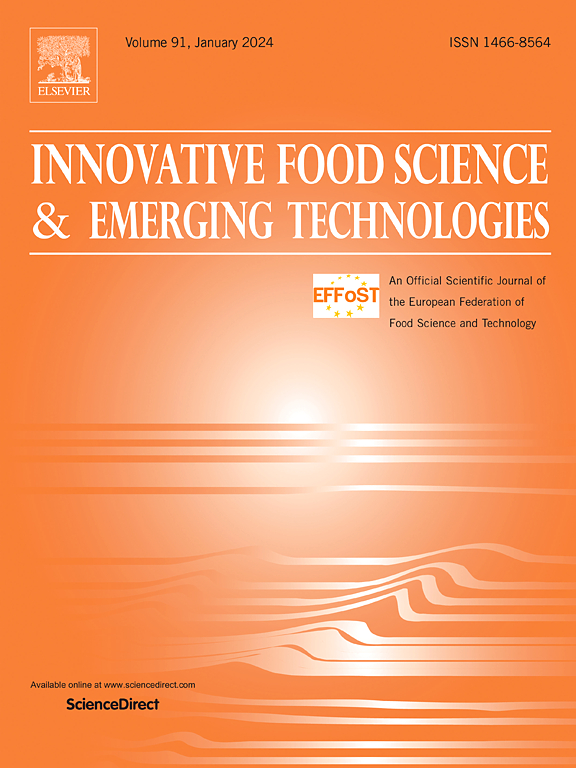高压均质预处理提高了藜麦蛋白水解物中类黄酮的释放和生物活性肽的产生:体外和硅片生物活性特性的分析
IF 6.8
1区 农林科学
Q1 FOOD SCIENCE & TECHNOLOGY
Innovative Food Science & Emerging Technologies
Pub Date : 2025-06-13
DOI:10.1016/j.ifset.2025.104088
引用次数: 0
摘要
本研究探讨了高压均质(HPH)预处理对Alcalase酶解藜麦分离蛋白(QPI)的影响,重点研究了蛋白溶解度、蛋白谱、水解度(DH)、游离氨基酸、总可溶性酚类化合物(TSPC)、血管紧张素转换酶抑制(ACEI)和抗氧化活性(AA),以及酚类物质和肽的表征。在50 MPa (QPH50)下预处理,DH从15.98%(未预处理的水解产物)降低到13.53%。水解产物含有较低的游离氨基酸水平(2.5-2.7 g/100 g)。可溶性蛋白减少,SDS-PAGE证实所有水解样品的球蛋白水解(> 25kda),小肽增加(< 5kda)。QPI水解提高了甲醇丙酮和水提物中的TSPC和AA,在50 MPa(水提物)时达到最高水平。3 kDa渗透液在0.5 mg/mL时表现出较强的ACEI活性(91.5 ~ 93.2%),其中QPH50表现出最高的抑制作用(92.6%;IC50 = 0.04 mg/mL)。进一步表征表明,QPH50的类黄酮含量增加(10.1 mg/100 g)。QPH50的肽组学分析鉴定出236个肽序列,27个预测生物活性,其中SPGYYDGR和AGLQFPVGR的多功能潜力最高。这项研究强调了HPH与酶解结合释放酚类物质和生物活性肽的有效性,具有高生物利用度和有前景的安全性。本文章由计算机程序翻译,如有差异,请以英文原文为准。
High-pressure homogenization pretreatment enhances flavonoid release and bioactive peptide production in quinoa protein hydrolysates: In vitro and in silico analysis of bioactive properties
This research explored the impact of high-pressure homogenization (HPH) at 50, 100, and 180 MPa as a pretreatment for enzymatic hydrolysis of quinoa protein isolate (QPI) using Alcalase, focusing on protein solubility, protein profile, degree of hydrolysis (DH), free amino acids, total soluble phenolic compounds (TSPC), angiotensin-converting enzyme-inhibitory (ACEI) and antioxidant activities (AA), and characterization of phenolics and peptides. Pretreatment at 50 MPa (QPH50) reduced DH from 15.98 % (non-pretreated hydrolysates) to 13.53 %. The hydrolysates comprised low free amino acid levels (2.5–2.7 g/100 g). Soluble protein decreased, and SDS-PAGE confirmed globulin hydrolysis (>25 kDa) for all hydrolysate samples, with an increase in small peptides (<5 kDa). QPI hydrolysis increased TSPC and AA in methanol-acetone and aqueous extracts, reaching their highest levels at 50 MPa (aqueous extract). The 3 kDa permeates showed strong ACEI activity at 0.5 mg/mL (91.5–93.2 %), with QPH50 exhibiting the highest inhibition (92.6 %; IC50 = 0.04 mg/mL). Further characterization of QPH50 showed enhanced flavonoid content (10.1 mg/100 g). Peptidomic analysis of QPH50 identified 236 peptide sequences, 27 predicted bioactive, with SPGYYDGR and AGLQFPVGR ranking highest for multifunctional potential. This study highlights the effectiveness of combining HPH with enzymatic hydrolysis to release phenolics and bioactive peptides, with high bioavailability and promising safety profiles.
求助全文
通过发布文献求助,成功后即可免费获取论文全文。
去求助
来源期刊
CiteScore
12.00
自引率
6.10%
发文量
259
审稿时长
25 days
期刊介绍:
Innovative Food Science and Emerging Technologies (IFSET) aims to provide the highest quality original contributions and few, mainly upon invitation, reviews on and highly innovative developments in food science and emerging food process technologies. The significance of the results either for the science community or for industrial R&D groups must be specified. Papers submitted must be of highest scientific quality and only those advancing current scientific knowledge and understanding or with technical relevance will be considered.

 求助内容:
求助内容: 应助结果提醒方式:
应助结果提醒方式:


